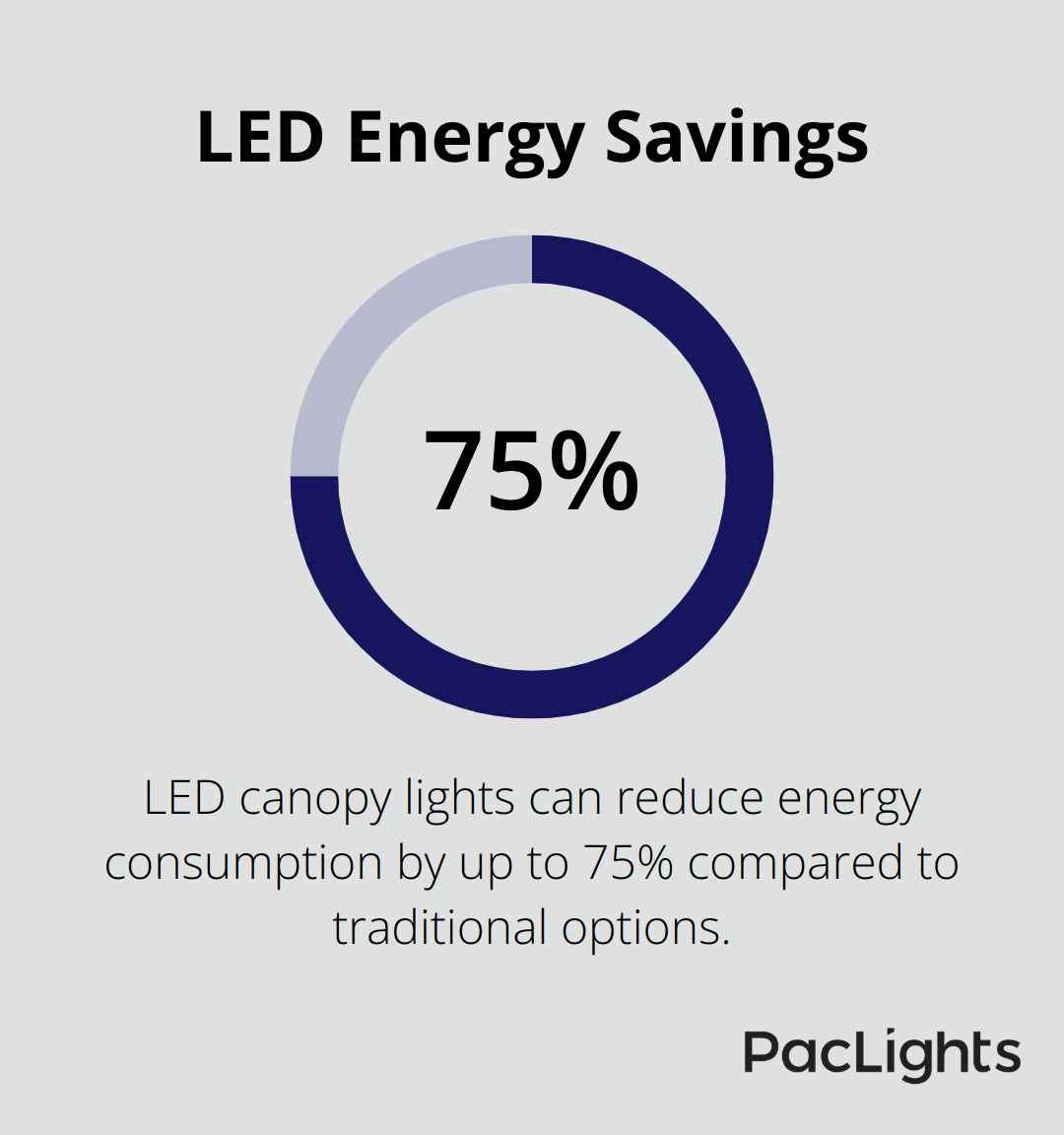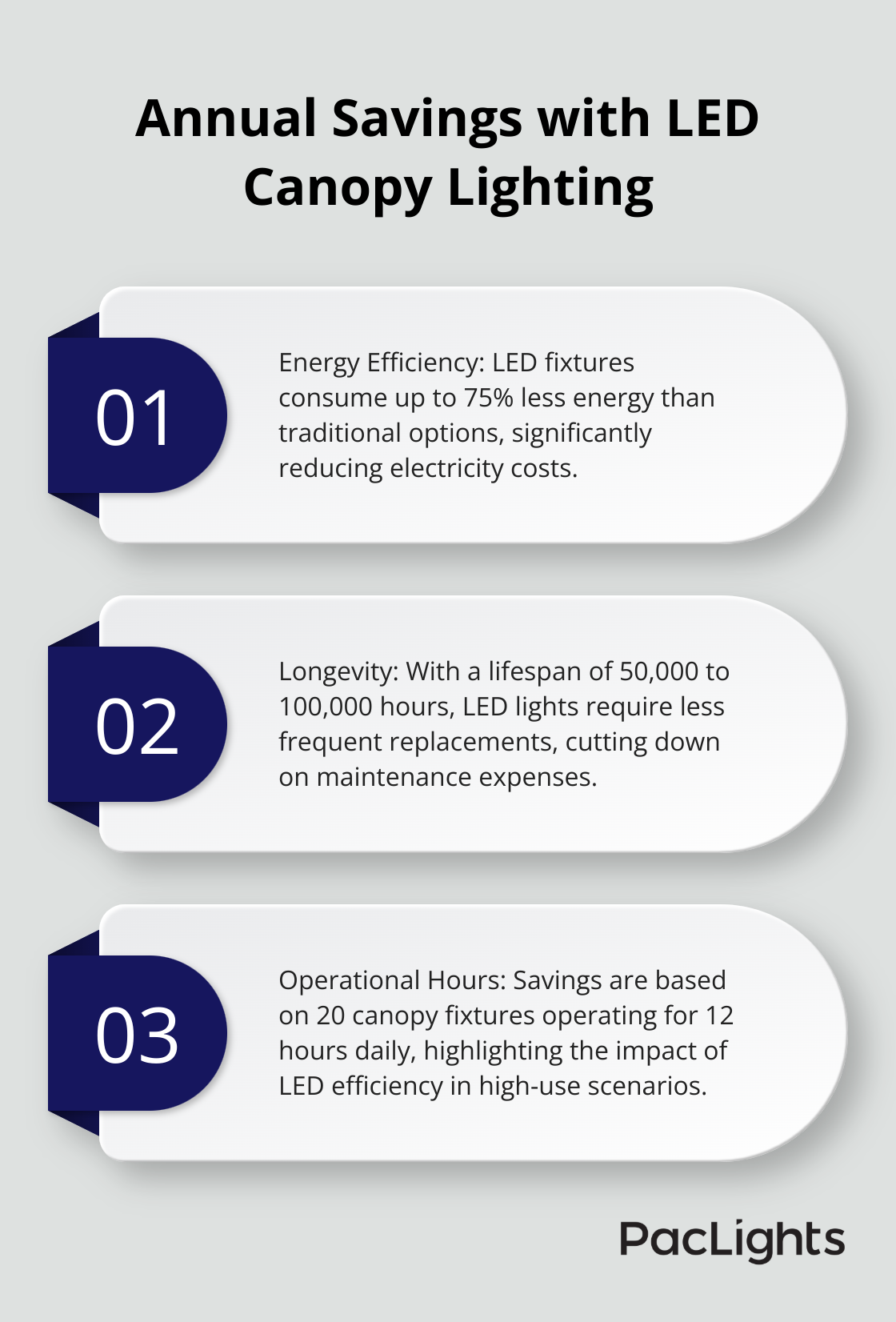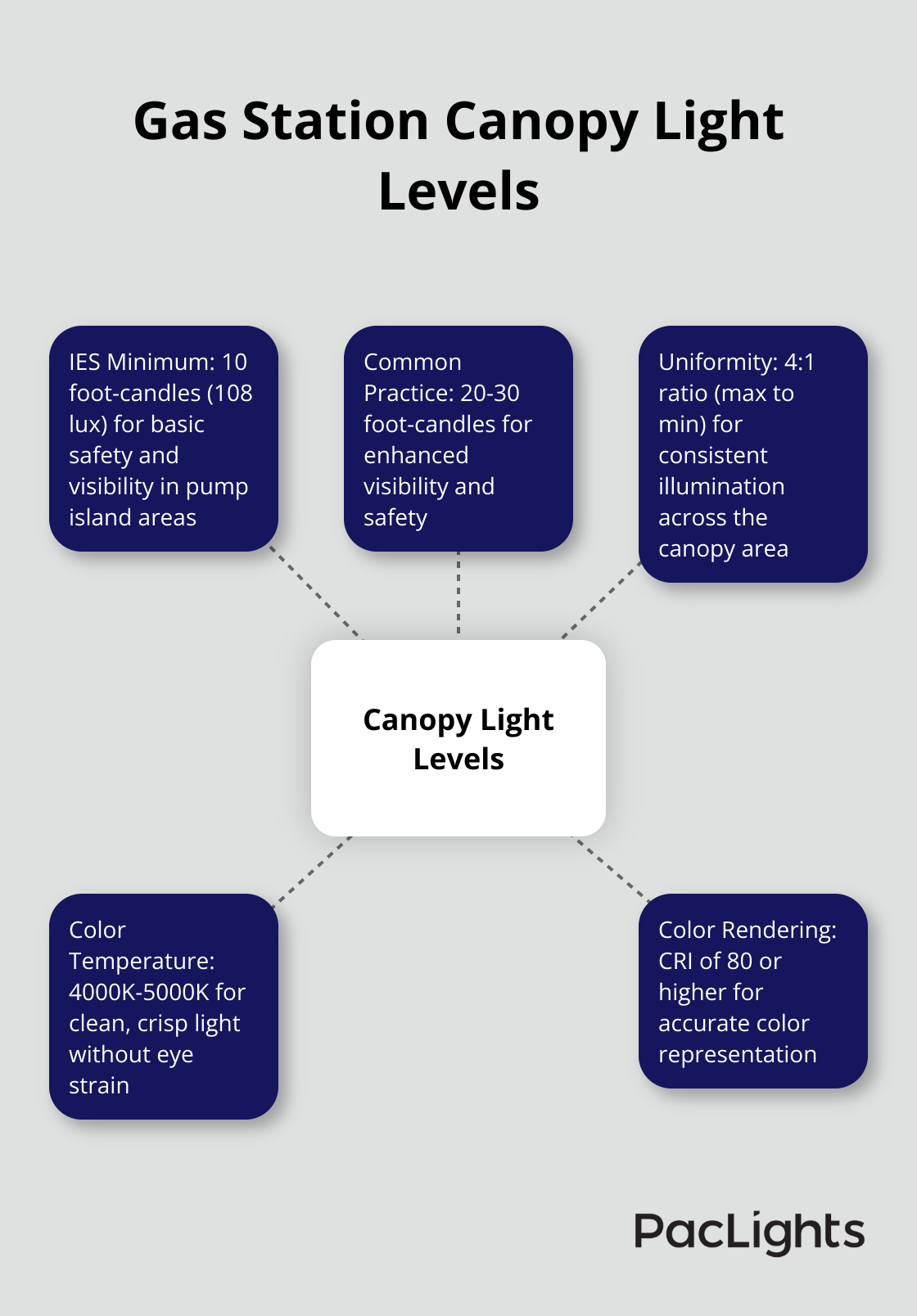Gas station canopy lighting plays a vital role in ensuring safety and visibility for customers and staff. At PacLights, we understand the importance of proper illumination in these high-traffic areas.
This blog post will explore the key considerations and best practices for effective gas station canopy lighting design. We’ll cover everything from fixture types to energy efficiency, helping you make informed decisions for your lighting projects.
What Are Gas Station Canopy Lights
Definition and Purpose
Gas station canopy lights are specialized lighting fixtures that illuminate the area beneath the canopy where vehicles refuel. These lights create a safe and inviting environment for customers and staff. The primary purpose of canopy lighting is to provide clear visibility for customers during fueling operations. Proper illumination prevents accidents, allows easy reading of fuel dispensers, and facilitates safe movement around the pumping area. Well-lit canopies also contribute to the overall security of the gas station, deterring potential criminal activities.
Common Fixture Types
Several types of fixtures are used for gas station canopy lighting:
- LED Canopy Lights: These have become increasingly popular due to their energy efficiency and long lifespan. LED fixtures often come in recessed or surface-mounted designs, with options for different light distribution patterns to suit various canopy layouts.
- Metal Halide Fixtures: Once a standard choice, these are now being phased out in favor of more efficient LED options. However, some stations still use them due to their high light output and relatively low initial cost.
Safety and Visibility Standards
Proper illumination is essential for maintaining safety standards at gas stations. The Illuminating Engineering Society (IES) recommends a minimum of 10 foot-candles (108 lux) for the pump island area. This level of lighting ensures that customers can safely operate fuel dispensers and navigate the area without tripping hazards.
Visibility also plays a key role in brand recognition and customer attraction. A well-lit canopy serves as a beacon for drivers, especially during nighttime hours. According to a study by the National Association of Convenience Stores, 45% of customers choose a gas station based on its appearance (with lighting playing a significant role in that decision).
Energy Efficiency and Maintenance
Energy efficiency should be a top priority when selecting gas station canopy lights. LED canopy lights can reduce energy consumption by up to 75% compared to traditional lighting options. This translates to significant cost savings over time, with some gas stations reporting annual energy savings of $5,000 or more after switching to LED canopy lights.

Maintenance is another critical factor. LED fixtures typically have a lifespan of 50,000 to 100,000 hours, significantly reducing the need for frequent replacements. This longevity not only cuts down on maintenance costs but also minimizes disruptions to station operations.
As we move forward, it’s important to consider the key factors that influence the effectiveness of gas station canopy lighting. Let’s explore these considerations in more detail.
What Makes Effective Gas Station Canopy Lighting
Brightness and Uniformity
Gas station canopy lighting must meet specific standards for safety and visibility. The Illuminating Engineering Society (IES) sets a minimum requirement of 10 foot-candles (108 lux) for pump island areas. Many gas stations opt for higher levels, typically between 20-30 foot-candles, to enhance visibility and safety. Uniformity plays an equally important role. A uniformity ratio of 4:1 or better (maximum to minimum light levels) ensures consistent illumination across the canopy area, which eliminates dark spots and improves overall safety.
Energy Efficiency and Cost-Effectiveness
LED technology has transformed gas station lighting. Modern LED canopy fixtures can cut energy consumption by up to 75% compared to traditional metal halide lamps. This reduction translates to substantial cost savings. A typical gas station with 20 canopy fixtures operating 12 hours daily can save over $3,000 annually by switching to LED lighting.

LED fixtures also boast a longer lifespan, often exceeding 50,000 hours. This longevity reduces maintenance costs and the frequency of replacements. When selecting fixtures, it’s important to look for those with high lumens per watt (efficacy) ratings. Top-performing LED canopy lights can achieve efficacies of 130-150 lumens per watt or higher.
Weather Resistance and Durability
Gas station canopy lights face exposure to harsh weather conditions, vehicle emissions, and occasional impacts. Durability, therefore, becomes paramount. Fixtures should have an Ingress Protection (IP) rating of at least IP65, which ensures protection against dust and water jets. Some high-quality fixtures even offer IP66 or IP67 ratings for enhanced protection.
Corrosion-resistant materials (such as die-cast aluminum housings and polycarbonate lenses) contribute to longevity. Additionally, fixtures should function reliably in a wide temperature range, typically from -40°C to 50°C (-40°F to 122°F), to ensure consistent performance in various climates.
Glare Reduction and Light Pollution Control
Glare can create significant issues in gas station lighting, causing discomfort for customers and potentially hazardous conditions. To mitigate this problem, fixtures with well-designed optics that direct light downward and minimize spill light prove most effective. Fixtures with a Unified Glare Rating (UGR) of 19 or lower offer optimal visual comfort.
Light pollution presents another concern, especially for gas stations in residential areas. Dark Sky compliant fixtures, which minimize upward light emission, address this issue effectively. Some municipalities have specific ordinances regarding light trespass and sky glow. It’s essential to check local regulations when designing your lighting system.
Products that offer adjustable light distribution patterns provide flexibility for customization based on the specific layout of your gas station. This adaptability ensures optimal light coverage while minimizing waste and light pollution.
The next chapter will explore best practices for gas station canopy lighting design, building on these key considerations to create an effective and efficient lighting system.
How to Design Effective Gas Station Canopy Lighting
Optimal Fixture Placement
Effective canopy lighting requires strategic fixture placement. Try to create uniform illumination across the entire canopy area, with emphasis on critical zones like fuel dispensers and payment terminals. A common approach positions fixtures in a grid pattern, typically spaced 10 to 15 feet apart (this spacing can vary based on canopy size and fixture output).
For larger canopies, use fixtures with wider beam angles to ensure adequate coverage. The objective is to achieve a uniformity ratio of 4:1 or better between the brightest and darkest areas. This level of uniformity eliminates shadows and ensures consistent visibility throughout the fueling area.
Color Temperature and Rendering
The color temperature of your lighting impacts the overall atmosphere of your gas station. Most experts recommend a color temperature between 4000K and 5000K for gas station canopies. This range provides a clean, crisp light that enhances visibility without causing eye strain.
Color rendering is equally important. Select fixtures with a Color Rendering Index (CRI) of 80 or higher. A high CRI ensures that colors appear natural and vibrant under the lighting, which is important for accurately reading fuel dispenser displays and product labels.
Integration with Surrounding Areas
Your canopy lighting should integrate seamlessly with other lighting zones in your gas station. The transition from the canopy area to the forecourt and building facade should be gradual to avoid stark contrasts that can be jarring to the eye.
Use similar color temperatures across all lighting zones to maintain visual consistency. For the forecourt area, try to set light levels at about 50% of the canopy illumination to create a smooth transition. The building facade lighting can be slightly lower (around 30-40% of the canopy levels) to draw attention to the canopy area while still providing adequate illumination for safety and branding.
Compliance and Standards
Adherence to local regulations and industry standards is essential when designing gas station canopy lighting. Many jurisdictions have specific requirements for light levels, uniformity, and light trespass. The Illuminating Engineering Society (IES) provides guidelines that are widely accepted in the industry.
The IES recommends a minimum of 10 foot-candles (108 lux) for pump island areas. However, many gas stations opt for higher levels, typically between 20-30 foot-candles, to enhance visibility and safety.

Be mindful of light pollution regulations, especially if your gas station is near residential areas. Use fixtures with well-designed optics that minimize upward light emission and light trespass. Some municipalities require Dark Sky compliant fixtures to reduce sky glow.
When selecting fixtures, ensure they meet relevant safety certifications. For hazardous locations like gas stations, fixtures should be UL listed for wet locations and comply with National Electrical Code (NEC) requirements.
Final Thoughts
Gas station canopy lighting creates safe, efficient, and inviting environments for customers and staff. It enhances safety, reduces operational costs, and improves the overall customer experience. The shift towards LED technology has revolutionized this field, offering significant energy savings and reduced maintenance requirements.
Professional lighting design is essential to achieve the best results. Experts can navigate the complexities of lighting requirements, ensure compliance with regulations, and create an optimal lighting plan. At PacLights, we offer comprehensive lighting solutions tailored to the unique needs of gas stations, including free lighting layout designs and ROI assessments.
The future of gas station canopy lighting will likely involve more advanced technologies. We expect to see increased integration of smart lighting systems that adjust output based on ambient conditions or occupancy. This could lead to further energy savings and improved user experiences, pushing the boundaries of energy conservation even further.


Disclaimer: PacLights is not responsible for any actions taken based on the suggestions and information provided in this article, and readers should consult local building and electrical codes for proper guidance.